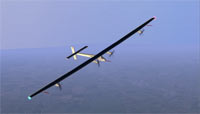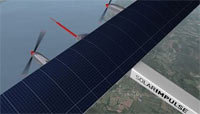Bertrand Piccard, who piloted the first balloon to circle the world non-stop, unveiled on November 5th the prototype design for the Solar Impulse, an aircraft meant to repeat that feat using only solar power. Called the HB-SIA, the prototype aircraft consists of a wing with a span of 200 feet, covered with solar cells. Despite that huge wing span, the craft will employ lightweight materials to tip the scales at only 3,300 pounds. That combination will allow the plane to fly at just 28 miles per hour, a speed that will keep energy consumption low, allowing the solar panels to not only power the craft during the day, but to also store up enough energy to keep it flying at night. Construction of the HB-SIA began in June and is expected to be complete by the summer of 2008.
However, the HB-SIA is not expected to circle the globe. Instead, it will serve as a prototype to test both the flying characteristics and the energy performance of the design. The craft will feature minimal instrumentation and a non-pressurized cockpit, which will force it to stay below 28,000 feet in elevation. Test flights are expected to begin in the fall of 2008, and the first all-night flight should occur in 2009. The Solar Impulse team hopes to build the final aircraft and fly it across the Atlantic Ocean by 2011, followed sometime later by the circumnavigation attempt. Piccard initiated the Solar Impulse project in 2003, but since then the team has grown to a multi-disciplinary team of 50 specialists from six countries, assisted by about 100 outside advisers.
Previous attempts at continuous solar-powered flight have only been performed using unmanned aircraft, and have met with mixed success. A craft using a fuel cell for night flight crashed in 2003, but an airplane using battery storage flew for two days straight in 2005. Earlier this year, an unmanned solar-powered airplane set a record by flying for 54 consecutive hours with the help of battery storage. In contrast, the first manned aircraft to circle the Earth without stopping was piloted by Burt Rutan and Jeana Yeager in 1986 and flew for 216 hours, consuming 6,900 pounds of fuel. The only solo aircraft to circle the Earth without stopping was piloted by Steve Fossett in 2005 and flew for 67 hours, consuming more than 18,000 pounds of fuel. Fossett disappeared two months ago while flying over Nevada and is presumed dead..

